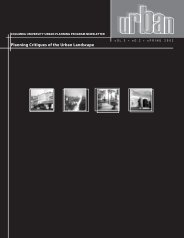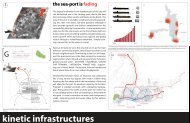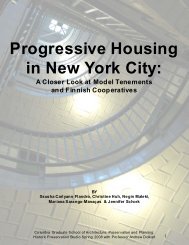The Art of Planning - Columbia University Graduate School of ...
The Art of Planning - Columbia University Graduate School of ...
The Art of Planning - Columbia University Graduate School of ...
Create successful ePaper yourself
Turn your PDF publications into a flip-book with our unique Google optimized e-Paper software.
12<br />
BIG names, BIG deals, and the growing pains <strong>of</strong> a post-industrial ‘it-town’ in Northern Spain.<br />
BY Leslie Alba and Minna Ninova<br />
BILBAO, 1997-2007<br />
<strong>The</strong> Guggenheim Museum in Bilbao, Spain opened to the public on October 19, 1997.<br />
Dramatic in form and innovative in content, it was an instant Mecca to many. As part <strong>of</strong><br />
the renowned Guggenheim dynasty, the museum<br />
Bilbao is the kind <strong>of</strong> city<br />
attracted art connoisseurs from around the globe,<br />
that can upgrade from a<br />
for whom the Guggenheim tag promised a new<br />
non-destination to a place and exciting curatorial adventure. <strong>The</strong> building<br />
where the Norman Fosters was designed by preeminent ‘starchitect’ Frank<br />
<strong>of</strong> the world want to build Gehry and was a calling for many fans <strong>of</strong> flashy<br />
architecture and tourists bored <strong>of</strong> the predictable<br />
their bridges. Yet, despite<br />
European destination; Bilbao made for added<br />
its opportunistic presence, novelty at the ticket counter. <strong>The</strong> City, however,<br />
how does this archetypal did not just seek to be the depository for Western<br />
Bilbao come into play with Europe’s next Guggenheim (Venice has one<br />
too), it wanted to be part <strong>of</strong> the artwork.<br />
the ‘Guggenheim Bilbao’?<br />
It is perhaps a sad fact <strong>of</strong> a planner’s life that<br />
news-making museums don’t fall from the sky – not even in Europe. In the case <strong>of</strong> the<br />
Guggenheim Bilbao, the development’s main proponent came in the shape <strong>of</strong> the Basque<br />
government, which saw an opportunity to redevelop the City’s antiquated and disinvested<br />
industrial waterfront. Bilbao had never been a town <strong>of</strong> glitz or glamour, and in fact still feels<br />
rugged and scabrous in comparison with the charm <strong>of</strong> nearby San Sebastian or the vibrancy<br />
<strong>of</strong> Barcelona. <strong>The</strong> government decided that foreign investment in the cultural sphere was<br />
the ammunition they needed for remaking Bilbao into an international destination. Placing<br />
the Guggenheim in Bilbao was thus a strategic move by the municipal government aimed<br />
at making an “art-place” out <strong>of</strong> the City. <strong>The</strong> move paid <strong>of</strong>f – the contrast between worldclass<br />
art and the Bilbao’s rusty industrial past struck editorial gold. Frank Gehry won<br />
international acclaim for his powerful, imposing steel design (which is emblematic <strong>of</strong> the<br />
City’s industrial character) and visitors poured past the turnstiles by the thousands; the<br />
“Bilbao Effect” was born.<br />
<strong>The</strong> Guggenheim directors wanted the building to be a daring, enduring artistic statement,<br />
looking to gritty industrial austerity as a backdrop for the project’s unabashed pas de<br />
deux. However, the bold nature <strong>of</strong> this intervention leads one to question whether the<br />
courtship between glamorous architecture and a no-name city answered the hopes <strong>of</strong><br />
Bilbao’s policymakers.<br />
Currently, the City <strong>of</strong> Bilbao can confidently say that many more people have crossed<br />
its borders since the Guggenheim opened its doors than they ever did before. Tourists<br />
typically visit for one or two days, attracted by the City’s famous designs and structures<br />
(Bilbao is also home to a Norman Foster subway station, and a bridge and airport terminal<br />
designed by Santiago Calatrava). Clearly, this town can lay claim to some beautiful<br />
public infrastructure, demonstrating how a city’s artwork doesn’t have to be confined to<br />
museums, but can also be woven into the fabric <strong>of</strong> everyday life. Ask a restaurateur in<br />
the Bilbao’s Casco Viejo neighborhood, however, and he or she is likely to give you a<br />
less emphatic account <strong>of</strong> how the tourists saved the City. <strong>The</strong> remark would probably<br />
go something like this: “<strong>The</strong>y come for the museum for one or two days to see Gehry’s<br />
building, Norman Foster’s sleek subway station, and Santiago Calatrava’s bridge and<br />
airport terminal. Big architecture – big deal! Are they in my restaurant? No. This building<br />
is older than Calatrava’s grandmother and I don’t see Zaha Hadid wanting to do anything<br />
about that. As far as I’m concerned, they may as well have dug a tunnel from the airport<br />
to the museum café.”*<br />
<strong>The</strong> would-be statements, like the one above, reveal that Bilbao is the kind <strong>of</strong> city that can<br />
upgrade from a non-destination to a place where the Norman Fosters <strong>of</strong> the world want<br />
to build their bridges. Yet, despite its opportunistic presence, how does this archetypal<br />
Bilbao place against the ‘Guggenheim Bilbao’? Technically and metaphorically speaking,<br />
it comes in second place. In other words, the physical and visual enhancements have their<br />
limitations, and the question we have to ask ourselves is: If we build it, will they come?<br />
More importantly, will they stay? Will investors and residents consider this Bilbao a place<br />
where they would like to plant their money trees? Is there anything to look at, and buy<br />
URBAN
















